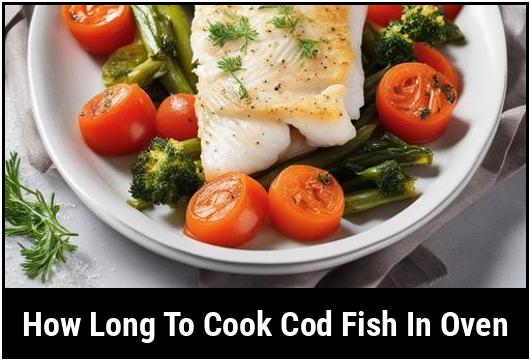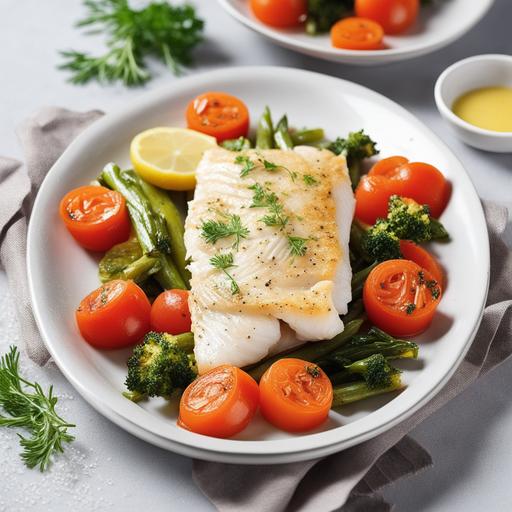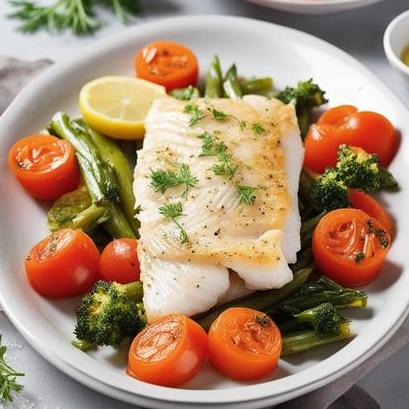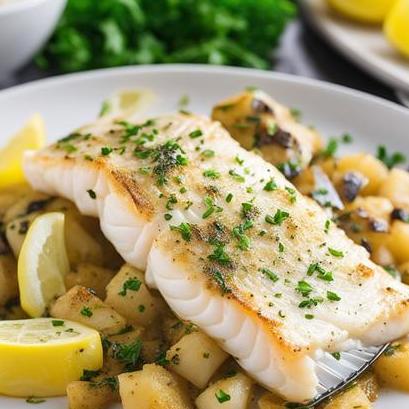[GUIDE] How Long To Cook Cod Fish In Oven

Cooking cod fish in the oven is a popular method that yields moist, flaky fish with minimal effort. Whether you are a seasoned chef or a beginner in the kitchen, knowing the proper cooking time and techniques can make all the difference in creating a delicious and perfectly cooked cod fish dish. In this article, we will delve into the science behind cooking cod fish, provide detailed instructions, offer troubleshooting tips, and explore creative variations for enhancing your culinary creations.
Quick Answer: How Long To Cook Cod Fish In The Oven
The cooking time for cod fish in the oven can vary depending on the thickness of the fillets and the desired level of doneness. As a general guideline, cod fish fillets that are approximately 1-inch thick should be cooked for about 10-15 minutes at a temperature of 400°F (200°C). However, it is essential to remember that cooking times may vary, so it is crucial to monitor the fish closely and check for doneness using a fork or a food thermometer.
Key Takeaways
- Cooking time for cod fish in the oven is generally around 10-15 minutes at 400°F (200°C) for 1-inch thick fillets.
- The internal temperature of cooked cod fish should reach 145°F (63°C) for optimal safety and doneness.
- Thicker fillets or whole cod fish may require longer cooking times.
- Different cooking techniques, such as baking, broiling, or roasting, can be used to achieve different textures and flavors.
- Proper seasoning and careful monitoring during cooking are essential for a delicious cod fish dish.
The Science Of Cooking Cod Fish

To understand how to cook cod fish to perfection, it is helpful to have a basic understanding of the science behind the cooking process. When cod fish is cooked, several chemical changes occur that impact the texture, flavor, and safety of the fish.
Protein Denaturation And Coagulation
Cod fish, like all seafood, is primarily composed of proteins. When cod fish is exposed to heat, the proteins in the fish denature and coagulate. This process causes the fish to firm up and become opaque. Overcooking cod fish can lead to the proteins becoming tough and dry, resulting in an unpleasant eating experience. It is crucial to cook the fish just until it reaches the desired doneness to preserve its delicate texture.
Maillard Browning Reaction

The Maillard browning reaction is another chemical process that occurs during cooking. It is responsible for the appealing golden-brown color and the development of rich flavors in cooked food. The Maillard reaction starts to occur around 230°F (110°C) and intensifies as the temperature rises. Achieving the right balance of Maillard browning without overcooking the fish requires careful monitoring and control of the cooking temperature.
Moisture Retention
Properly cooked cod fish should be moist and tender. However, overcooking can cause the fish to become dry and lose its moisture. Moisture loss occurs when the heat causes the proteins to contract, squeezing out the water within the fish. To retain moisture, it is essential to cook the cod fish for the appropriate amount of time and avoid exposing it to excessively high temperatures.
Choosing Cod Fish

When cooking cod fish, it is crucial to select fresh, high-quality fish to ensure optimal flavor and texture. Here are some tips for choosing the best cod fish:
- Freshness: Look for cod fish with clear, bright eyes, vibrant skin, and a fresh sea scent. Avoid fish with cloudy eyes, dark or dull skin, or a strong odor.
- Texture: The flesh of fresh cod fish should be firm, shiny, and have a slight bounce when touched. Avoid fish with soft or mushy flesh.
- Sustainability: Choose cod fish that has been sustainably harvested to support responsible fishing practices and help protect the environment.
If fresh cod fish is not available, frozen cod fish can also be used. Just make sure to thaw the fish properly before cooking to avoid uneven cooking or loss of moisture.
Preparing Cod Fish
Before cooking cod fish, it is essential to properly prepare it to enhance its flavor and ensure even cooking. Follow these steps for preparing cod fish:
-
Thawing: If you are using frozen cod fish, thaw it in the refrigerator overnight or in a sealed plastic bag submerged in cold water. Avoid thawing at room temperature to prevent bacterial growth.
-
Rinsing: Rinse the cod fish fillets under cold water to remove any excess ice or frost.
-
Patting dry: Use paper towels to pat the cod fish fillets dry. Removing excess moisture will promote better browning and prevent the fish from steaming instead of browning in the oven.
-
Seasoning: Season the cod fish fillets with salt, pepper, and any desired herbs or spices. This will add flavor to the fish during cooking. You can also marinate the cod fish in a mixture of lemon juice, olive oil, and herbs for added flavor.
Pro Tip: Avoid using too much salt in the seasoning, as it can draw out the moisture from the fish, making it dry.
Ideal Cooking Temperature For Cod Fish

The ideal cooking temperature for cod fish is around 400°F (200°C). This temperature allows for the proper denaturation of proteins, the development of Maillard browning, and effective moisture retention. Cooking the cod fish at a higher temperature can cause it to dry out, while cooking at a lower temperature may result in undercooked fish.
Using an oven thermometer is recommended to ensure the oven is correctly preheated to the desired temperature. Oven temperatures can vary, so it is essential to rely on an accurate thermometer rather than solely relying on the oven’s temperature display.
Cod Fish Cooking Time
The cooking time for cod fish can vary based on several factors, including the thickness of the fillets and the desired level of doneness. As a general guideline, cod fish fillets that are approximately 1-inch thick should be cooked for about 10-15 minutes at 400°F (200°C). However, it is crucial to monitor the fish closely and check for doneness using a fork or a food thermometer.
The internal temperature of cooked cod fish should reach 145°F (63°C) for optimal safety and doneness. Insert a food thermometer into the thickest part of the fillet to ensure it has reached the correct temperature. If the fillets are thicker or you prefer a more well-done fish, you may need to increase the cooking time by a few minutes.
Pro Tip: If cooking a whole cod fish or a larger piece with bones, adjust the cooking time accordingly. As a general rule, allow an additional 5-10 minutes of cooking time per inch of thickness for whole fish.
Cooking Techniques

There are several cooking techniques you can use to cook cod fish in the oven, each offering unique textures and flavors. Here are three popular cooking techniques for cod fish:
-
Baking: Baking cod fish in the oven is a simple and foolproof method that results in moist and tender fish. Place the seasoned cod fish fillets on a greased or parchment-lined baking sheet and cook in the preheated oven at 400°F (200°C) for about 10-15 minutes or until the internal temperature reaches 145°F (63°C).
-
Broiling: Broiling cod fish under high heat allows for quick and intense cooking, resulting in a slightly charred exterior and moist interior. Preheat the broiler on high and place the seasoned cod fish fillets on a greased or foil-lined baking sheet. Place the baking sheet on the top rack, about 4-6 inches away from the broiler. Broil for 4-6 minutes per side or until the internal temperature reaches 145°F (63°C).
-
Roasting: Roasting cod fish in the oven provides a flavorful and slightly crispy exterior. Preheat the oven to 400°F (200°C) and place the seasoned cod fish fillets in a greased baking dish or on a wire rack set over a baking sheet. Roast for 10-15 minutes or until the internal temperature reaches 145°F (63°C).
Pro Tip: To achieve a more intense flavor, you can brush the cod fish fillets with melted butter, olive oil, or a marinade of your choice before cooking.
Monitoring And Troubleshooting
Monitoring the cooking process is crucial to avoid overcooking the cod fish. Here are some tips for monitoring and troubleshooting:
- Visual cues: Keep an eye on the fish while it cooks. The cod fish should turn opaque and start to flake easily when it is done.
- Internal temperature: Using a food thermometer, check the internal temperature of the cod fish. It should reach 145°F (63°C).
- Flake test: Insert a fork into the thickest part of the fillet and gently twist. If the fish flakes easily, it is done. If it appears translucent or resists flaking, it needs more time to cook.
- Avoid opening the oven frequently: Opening the oven door frequently can cause fluctuations in temperature, resulting in uneven cooking. Only open the oven when necessary and keep cooking times as accurate as possible.
- Troubleshooting dry fish: If the cod fish turns out dry, it may have been overcooked. Adjust the cooking time or oven temperature for the next time. Alternatively, you can try basting the fish with a light sauce or wrapping it in foil before cooking to help retain moisture.
- When in doubt, undercook slightly: If you are unsure about the doneness of the cod fish, it is better to slightly undercook it than to overcook it. You can always return it to the oven for additional cooking if needed.
Cod Fish Cooking Instructions

Now that you are well-equipped with the knowledge of cooking cod fish, here is a step-by-step guide to ensure a successful cooking experience:
-
Preheat the oven to 400°F (200°C) and adjust the oven rack to the center position.
-
Season the cod fish fillets with salt, pepper, and any desired herbs or spices.
-
Place the seasoned cod fish fillets on a greased or parchment-lined baking sheet.
-
Cook the cod fish in the preheated oven for about 10-15 minutes or until the internal temperature reaches 145°F (63°C). For thicker fillets or whole fish, you may need to increase the cooking time by a few minutes.
-
Remove the cod fish from the oven and let it rest for a couple of minutes before serving. This allows the juices to redistribute, resulting in a more flavorful fish.
Variations
While plain baked, broiled, or roasted cod fish is delicious on its own, you can experiment with different flavors and ingredients to enhance your cod fish dish. Here are some popular variations:
- Lemon Herb Cod: Brush the cod fish fillets with melted butter or olive oil, then sprinkle them with a mixture of fresh herbs (such as parsley, dill, or thyme), lemon zest, salt, and pepper. Bake, broil, or roast as usual.
- Parmesan Crusted Cod: Combine grated Parmesan cheese, breadcrumbs, garlic powder, dried herbs, and salt in a bowl. Dip the cod fish fillets in beaten egg, then coat them in the Parmesan mixture. Bake in the oven until golden and cooked through.
- Tomato Basil Cod: Spread a layer of sliced tomatoes and fresh basil leaves on top of the cod fish fillets. Drizzle with olive oil and season with salt and pepper. Roast in the oven until the fish is cooked and the tomatoes are slightly caramelized.
- Asian-Inspired Cod: Marinate the cod fish fillets in a mixture of soy sauce, ginger, garlic, and honey before baking, broiling, or roasting. Serve with steamed rice and stir-fried vegetables for a complete meal.
Feel free to get creative and experiment with different seasonings, sauces, and accompaniments to discover your favorite flavor combinations.
When Things Go Wrong
Even with careful planning and execution, cooking mishaps can sometimes occur. Here are some common issues that may arise when cooking cod fish and how to address them:
- Dry fish: If the cod fish turns out dry and overcooked, try adjusting the cooking time or oven temperature for the next time. You can also try basting the fish with a light sauce or wrapping it in foil before cooking to retain moisture.
- Fish not cooked through: If the cod fish doesn’t reach the desired level of doneness, simply return it to the oven for additional cooking. Depending on the thickness of the fillets, it may require an additional 2-5 minutes of cooking time.
- Fish sticking to the baking sheet: To prevent the cod fish from sticking to the baking sheet, make sure to use a greased sheet or line it with parchment paper. The fish should release easily after cooking.
Remember that cooking is a learning process, and even professional chefs encounter challenges in the kitchen. Don’t be discouraged by minor setbacks and use them as opportunities to improve your cooking skills.
Serving Cod Fish
Once the cod fish is cooked to perfection, it is time to serve and enjoy your culinary creation. Here are some serving suggestions:
- Simple Presentation: Serve the cod fish fillets on a plate or a platter, garnished with fresh herbs or lemon slices. Pair it with a side of steamed vegetables, such as asparagus or broccoli, and a starch of your choice, such as mashed potatoes or rice.
- Fish Tacos: Flake the baked or broiled cod fish and serve it in warm tortillas with shredded lettuce, diced tomatoes, sliced avocado, and a squeeze of lime juice. Top it off with a dollop of sour cream or a drizzle of your favorite sauce.
- Cod Fish Chowder: Cube the cooked cod fish and use it as the main ingredient in a creamy fish chowder. Combine it with diced potatoes, onions, celery, carrots, and seasonings of your choice in a large pot. Simmer until the vegetables are tender and the flavors meld together.
- Fish and Chips: For a classic English-style fish and chips experience, serve the cod fish fillets alongside homemade potato wedges or fries. Accompany it with tartar sauce and malt vinegar for an authentic touch.
Feel free to get creative with your sides, sauces, and presentations to suit your taste preferences and dietary needs.
Best Practices For Cod Fish Cooking
To ensure consistently delicious results when cooking cod fish in the oven, consider the following best practices:
- Choose fresh and high-quality fish: Opt for fresh cod fish with a bright appearance, firm texture, and fresh scent. This will ensure the best flavor and texture in your final dish.
- Properly season the fish: Use a combination of salt, pepper, and herbs or spices to enhance the flavor of the cod fish. Avoid using excessive salt, as it can draw out moisture from the fish.
- Preheat the oven: Ensure that the oven is preheated to the correct temperature before cooking the cod fish. This will promote even cooking and the development of desirable textures.
- Monitor cooking time and temperature: Keep a close eye on the cod fish while it cooks, and use a food thermometer to check for the correct internal temperature. This will help prevent overcooking and achieve the desired level of doneness.
- Let the fish rest before serving: Allow the cooked cod fish to rest for a couple of minutes before serving. This allows the juices to redistribute, resulting in a more flavorful and tender fish.
Following these best practices will help you consistently create delicious and perfectly cooked cod fish dishes, whether you are cooking for yourself or entertaining guests.
Conclusion
Cooking cod fish in the oven can be a rewarding experience, resulting in moist, flaky, and flavorful fish. By understanding the science behind the cooking process, selecting fresh fish, properly preparing the fish, and using the right cooking techniques, you can achieve excellent results every time. Remember to monitor the cooking process, check for doneness using visual cues or a food thermometer, and experiment with different flavors and variations to create your own signature cod fish dishes. With practice and attention to detail, you will become a master of oven-baked cod fish and delight your taste buds and those of your guests.
FAQS
How Long Does It Take To Cook Cod Fish In The Oven At 350 Degrees Fahrenheit?
It should take around 25-30 minutes to cook cod fish in the oven at 350 degrees Fahrenheit. However, the cooking time may vary depending on the thickness of the fish and your oven’s heat consistency.
Can You Cook Cod Fish In The Oven At 400 Degrees Fahrenheit?
Yes, you can cook cod fish in the oven at 400 degrees Fahrenheit. At this temperature, it should take around 15-20 minutes to cook, again, depending on the thickness and size of the fish.
What Is The Best Way To Season Cod Fish For Oven Cooking?
You can season cod fish with herbs and spices such as rosemary, thyme, garlic, paprika, or lemon pepper. It is also advisable to add some olive oil or butter to keep the fish moist and flavorful. Salt and black pepper are a must-have seasoning as well.
Can I Bake Frozen Cod Fish In The Oven?
Yes, you can bake frozen cod fish in the oven, but make sure to increase the baking time by approximately 15 minutes. It is recommended, though, to thaw the fish before cooking to fully absorb the seasoning and guarantee even baking.
How Do I Know When The Cod Fish Is Cooked In The Oven?
The best way to check if the cod fish is fully cooked is by checking its internal temperature, which should reach 145 degrees Fahrenheit. You can also do the flake test, which means gently pulling a fork through the thickest part of the fish. If the flesh is opaque and easily flakes apart, it’s good to go.
Sources
About the Author Jenny
I'm Jenny, a housewife with an unwavering passion for food. My culinary journey began with my grandmother's kitchen, and it's now a full-fledged food blog. I've turned my love for cooking into a creative outlet, sharing recipes and stories with a global community of fellow food enthusiasts. It's proof that being a housewife can also mean pursuing your passions and savoring life's delectable moments.
